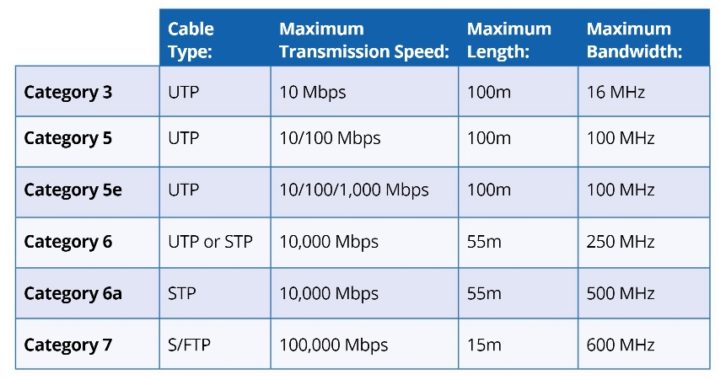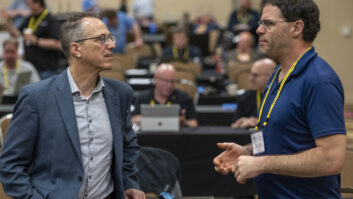This article is based on an excerpt from the Society of Broadcast Engineers CBNT/CBNE Study Topics webinar series, designed to assist those seeking SBE certification and to provide others a broad overview of IT as used in broadcast engineering.
Ethernet cabling may not be the most exciting topic, and as a result it can be taken for granted when a broadcast engineer builds the information technology infrastructure of a broadcast station.

But industry research suggests that the most common causes of Ethernet failures in a network or IT system are found in the cabling and connectors.
An Ethernet cable is just an Ethernet cable, it might seem; however, that is far from reality. There are several varieties of Ethernet in use, and choosing the right cable is important to ensure a reliable network that meets the performance capabilities.
Understanding industry terminology is often the key to applying technology correctly. The days of coaxial cable-based Ethernet are long gone from our broadcast systems, with the bus-based architecture replaced with a star-based topology utilizing a twisted-pair copper cable between a host device and an Ethernet switch port.
Classifications
So what are the differences in Ethernet cables? The question can be answered in a couple of ways.
One approach is to look at the various cable category classifications to choose an Ethernet cable based on the required bandwidth performance characteristics for your application.
Performance characteristics commonly include bandwidth, transmission speed and maximum cable length, as illustrated in the accompanying chart.

Unshielded twisted-pair (UTP) cable can be used up to 100 meters in length if Category 5e (CAT-5e) cabling is used. Shielded twisted-pair (STP) is capable of 10 Gbps up to 55 meters in length if Category 6a (CAT-6a) cabling is used. And even 100 Gbps up to 15 meters is possible over twisted pair copper if Category 7 (CAT-7) cable is used, which shields individual pairs in foil and an overall cable braided shield (S/FTP).
Another approach is to consider the cable installation environment and choose the physical construction of the Ethernet cable that fits the application and environment. Environmental considerations include the use of plenum-rated cable to meet building fire-code regulations. It is likely these cables would be required when the cabling is run through air circulation space in buildings. Plenum cable is manufactured with an overall, fire-resistant jacket such as Teflon so that if exposed to heat, the cable will not emit dangerous fumes. Plenum-rated Ethernet cable will have a CMP-rated jacket that is certified by Underwriters Laboratories.
Other environmental conditions might require outside cable installation where ultraviolet-resistant (UV) cable should be used. Outdoor-rated cable is also desirable due to the moisture-blocking characteristics and life expectancy that will vary in temperature extremes.
Direct-bury cable is available, providing a heavier overall jacket and additional moisture protection by wrapping waterproof tape around the conductors and impregnating or flooding the cable with waterproof gel. Outdoor and direct-bury-rated Ethernet cable will have a CMX-rated jacket.
One consideration often overlooked when selecting Ethernet cabling is the use of Power over Ethernet, or PoE. IEEE 802.3xx PoE standards provide a nominal 48 Vdc to powered host devices with different PoE power capability ranging from a 12.95-watt limit under 802.3af standard to up to 100 watts under the 802.3bt standard.
Factors that must be considered include the temperature rating of the cable due to heat rise resulting from resistance loss of the conductor pairs and overall power insertion loss. Use of 23 AWG-based conductor cable is preferred over the more common 26 AWG conductors when PoE is used.
[Sign Up for Radio World’s SmartBrief Newsletter]
When installing Ethernet cabling, I would look to CAT-6a or CAT-6 category cabling with the appropriate environmental rating. CAT-6 should be preferred over the shielded CAT-6a when PoE is utilized, especially when the higher-wattage PoE devices are used due to the ability of shielded cable to dissipate less heat.
Proper cable installation is also critical to ensure performance, especially in higher-bandwidth applications. Common recommended installation practices specify a minimum bending radius of the cable, bundling cables together (especially when PoE is utilized), and placement adjacent to other cabling such as AC power cables.
Use of the proper connector is critical to maintain system reliability. Shielded cable requires a shielded RJ-45 connector to maintain the noise immunity performance.
Not all Ethernet cables are created equal. The age-old twisted-pair copper cable can transport an increasing amount of data (and power) in our technical plant if the proper cable category and rating is chosen for the application. And the popularity, cost, ease of installation and termination of twisted-pair copper cannot be beat!
Stay tuned for my next article, which will focus on the Ethernet switch.
Questions and comments are welcomed at [email protected]
The webinar on which this article is based, and many others, are available to anyone for a modest fee, with members receiving a discounted rate and free to those with the SBE MemberPlus upgrade. Consider joining if you are not a member at sbe.org.







